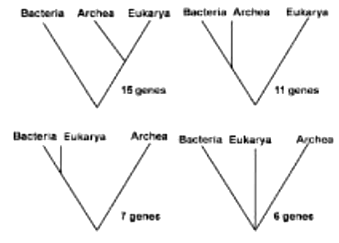 Multiple Choice Questions
Multiple Choice QuestionsWhen James R Brown and W Ford Doolittle (1997) reconstructed the tree of life using a variety of different genes, they found that different genes gave fundamentally different phylogenies as shown below. Note that the genes are unique to the specific trees.

From the given options select the process that best explains the observed discrepancies between the trees.
polyploidization
horizontal gene transfer
allopatric speciation
localized extinctions
Given below are names of some of the National Parks of India and their key protected animals.
| Name of the National Park | Key protected animal |
| A. Dibru-Saikhowa National Park, Assam | i. Indian Rhinoceros |
| B. Jaldapara National Park, West Bengal | ii. Hangul |
| C. Mukurthi National Park, Tamil Nadu | iii. Feral Horse |
| D. Dachigam National Park, Jammu and Kashmir | iv. Asiatic Lion |
| E. Gir Forest National Park, Gujarat | v. Nilgiri Tahr |
Based on the table given above, which of the following options represents the correct match?
A - iii; B - i; C - iv; D - ii; E - v
A - i; B - ii; C - v; D - iii; E - iv
A - i; B - ii; C - iii; D - iv; E - v
A - iii; B - i; C - v; D - ii; E - iv
Given below are larval stages and phylum to which they belong. Select the INCORRECT combination.
Parenchyma and Amphiblastula -Phylum Porifera
Bipinnaria and Auricularia - Phylum Echinodermata
Tornasia and Axolotl - Phylum Hemichordata
Planula and Ephyra - Phylum Cnidaria
Euphorbiaceae generally represents milky sap bearing plants but there are also some non-milky sap bearing plants that belong to this family. Identify the correct combination of the following given plants which belong to family Euphorbiaceae.
Terminalia bellirica, Euphorbia hirta, Nerium indicum
Mallotus philippense, Ficus religiosa, Ricinus communis
Mallotus philippense, Acalypha indica, Emblica officinalis
Acalypha indica, Ricinus communis, Mangifera indica.
C.
Mallotus philippense, Acalypha indica, Emblica officinalis
The correct combination of the plants that belong to family Euphorbiaceae are Mallotus philippense, Acalypha indica, Emblica officinalis.
Among the following statements, which is the correct one that refers to a Holotype?
Specimens collected from different locations and designated as type specimens by the author.
A single specimen or illustration upon which name is based and designated as nomenclature type by the author.
Specimens collected from different places and designated as type specimens.
A single specimen designated to serve as the nomenclatural type when all of the materials on which the name of the taxon was based is missing.
Which of the following statements is INCORRECT about a keystone species?
Species other than consumers can be a keystone species.
Keystone species has an influence on a community proportionate to its abundance.
Removing a keystone species can reduce species richness of a community.
Removing a keystone species can affect successive trophic levels causing a trophic cascade.
In the context of diveristy patterns of species, which one of the following statements is INCORRECT?
Alpha diversity is diversity within a single community.
Beta diversity is a measure of the change in species composition from one community or habitat to another.
Alpha diversity is the regional diversity found among a range of communities in a geographical region.
Gamma diversity is the regional diversity found among range of communities/ habitats in a geographical region.
Bipinnaria and brachiolaria are the larval forms of
Crustacea
Arthropoda and Mollusca, respectively
Ophiuroidea and Holothuroidea respectively
Asteroidea
The animals belonging to phylum Onychophora
have arthropodan characteristics and thus also considered as a class of Arthropoda
have both annelidan and arthropodan characteristics
have both arthropodan and molluscan characteristics
serve as a connecting link between Annelida and Mollusca
Which one of the following parameters is not used in phenetic classification of bacteria?
trophism
susceptibility of a bacteria to a particular bacteriophage
reaction to a particular antibody
16S rRNA sequence
